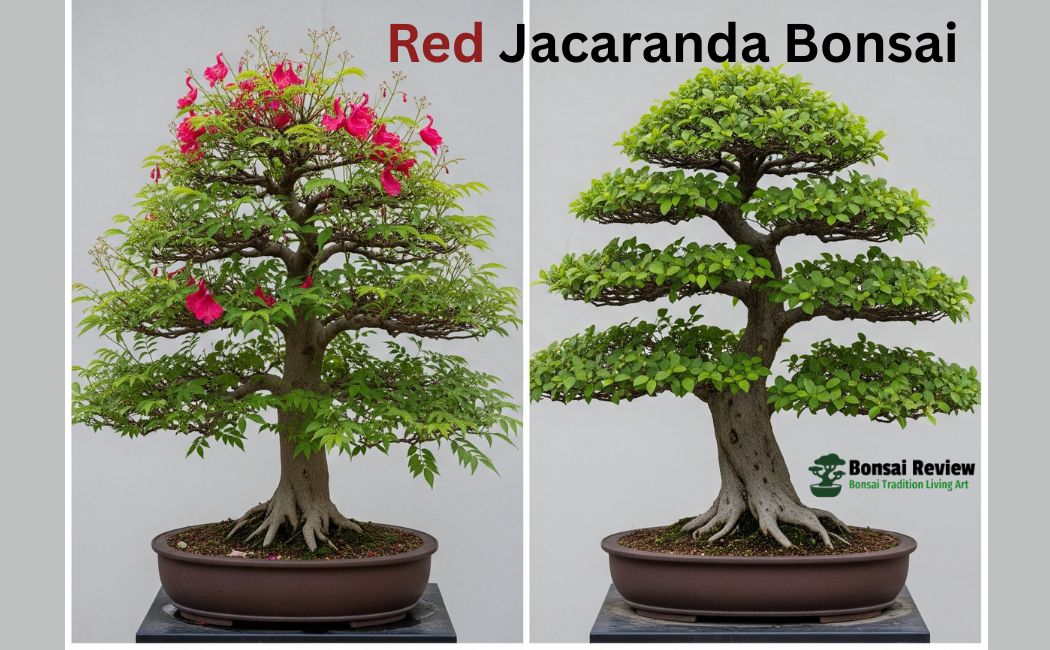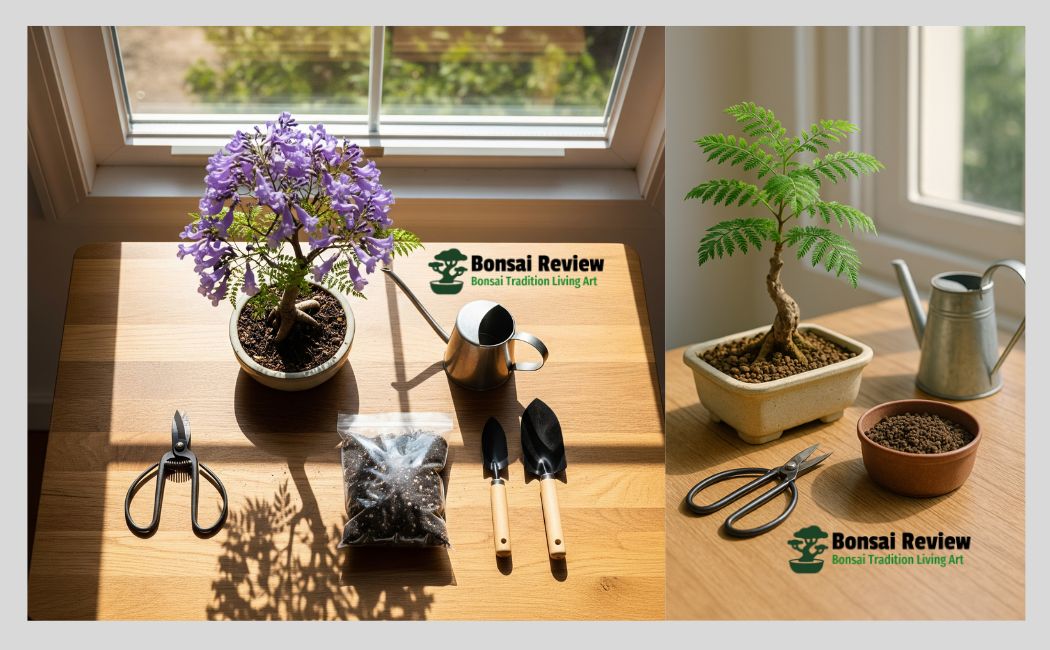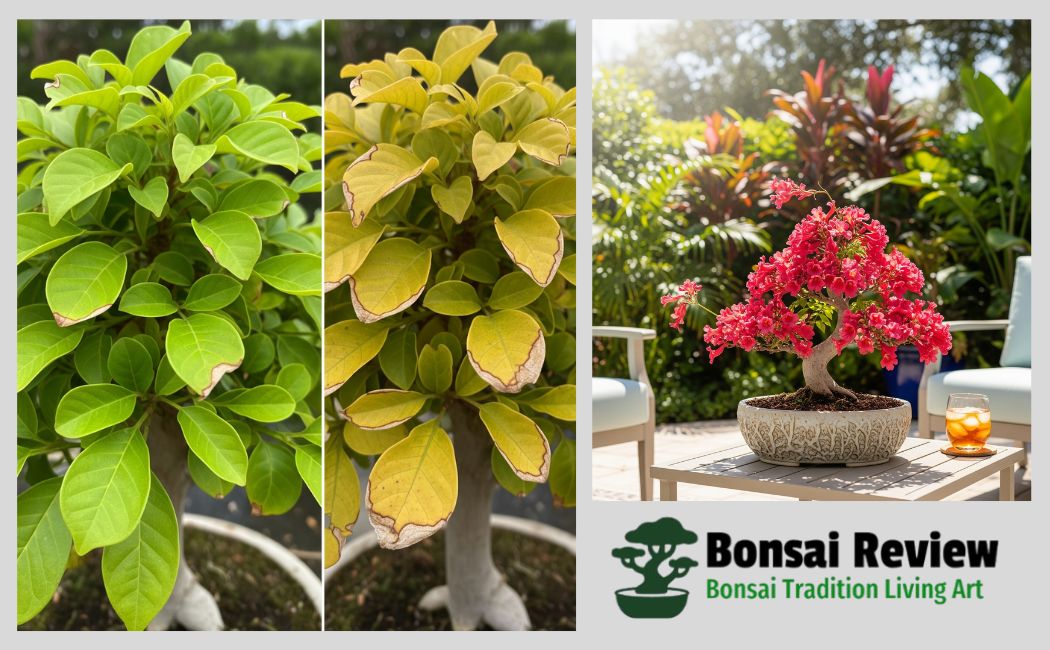Yes, generally Red Jacaranda Bonsai in Florida, USA. Particularly in the southern and central regions. They thrive in the warm, sunny conditions and well-drained soil common in those areas.
While not native, they are well-adapted to USDA Hardiness Zones 9B through 11, which include much of Florida. So, a red jacaranda bonsai tree can be a beautiful and smart pick for your home in Florida, USA.
The Red Jacaranda Indoor dwarf plant, also known as Jacaranda mimosifolia, is a smaller, potted version of the tall trees commonly found in South America, particularly in Brazil or Argentina.
It’s known for its fern-like leaves and eye-catching purple blooms, sometimes called “red” when the flowers look deeper or more reddish in sunlight. This bonsai tree thrives in warm conditions, full sun, and well-drained soil, making it an ideal match for Florida’s climate.
Since most of Florida falls in USDA Zones 9 to 11, the weather is just right for growing jacarandas outdoors or near bright windows. The tree can even handle short dry spells, and its roots are strong when cared for in the right soil mix.
But not everything is easy. Jacaranda trees don’t like too much humidity, which is common during Florida’s rainy season. Without proper airflow or drainage, they may suffer from root rot or fungus.
They’re also not salt-tolerant, so if your home is near the beach, salty wind or soil might be a problem. And since they’re semi-deciduous, they may drop leaves in winter or if they feel stressed.
Still, with the right care, good drainage, regular pruning, and lots of sunlight, this tree can bring real beauty and a peaceful, tropical vibe to your space. How to grow it the right way, and if it truly fits your home and lifestyle.
What Is a Red Jacaranda Bonsai Tree?
A Red Jacaranda Bonsai in Florida, USA is a small, shaped version of the Jacaranda mimosifolia tree. This tree is part of the Bignoniaceae family and is native to South America, especially in places like Brazil, Argentina, and Bolivia.
In warm areas, the full-sized tree can grow very tall and wide, with huge bursts of bright flowers. But when grown as a bonsai, it stays small enough to fit on a patio table or sunny windowsill.
The leaves are soft and feathery, like little green ferns. In spring and early summer, it can bloom with purple flowers that look almost red when the sun hits them just right.
That’s why many people call it a “red jacaranda,” though the official color is more purple or lavender. These blooms don’t last forever, but when they do appear, they give a magical look to the plant.
Jacaranda bonsai trees are loved not just for their look, but also for their symbolism. In many cultures, jacarandas stand for wisdom, creativity, and new beginnings. That’s why this bonsai is often seen as more than just a plant; it’s a little piece of nature that brings peace and meaning into the home.
Because of its fast growth, the jacaranda is also fun to shape and trim. It responds well to pruning, which means you can style it in many ways. That’s one reason why it has become so popular among bonsai growers, especially in places with warm weather like Florida, USA.
Why Love Red Jacaranda Bonsai In Florida? Ideal Growing Conditions.
Florida is one of the best places in the United States to grow a red jacaranda bonsai. This tree loves warmth, sunlight, and tropical weather, which makes it feel right at home in most parts of the state.
The jacaranda grows well in USDA Hardiness Zones 9 to 11, and Florida fits right into that zone range. These zones mean that winters are mild, and the tree won’t have to deal with freezing temperatures very often.
That’s important because Jacaranda mimosifolia doesn’t like cold weather at all. Even a little frost can hurt its leaves or roots, especially when it’s young.
This bonsai also needs at least 6 to 8 hours of direct sunlight every day, and Florida’s long, sunny days give it just that. You can keep it on a balcony, patio, porch, or near a sunny window, and it will thrive as long as it gets enough light.
Another reason Florida is a good fit is that jacarandas enjoy a bit of heat. The tree can handle high summer temperatures, as long as the soil drains well and doesn’t stay soggy.
That’s easy to manage with the right bonsai pot and soil mix. A loose, well-drained soil, with things like pumice, perlite, or akadama helps keep the roots healthy.
And while Florida sometimes has dry spells, the jacaranda is also somewhat drought-tolerant. If you forget to water for a day or two, it won’t die right away. That makes it easier to care for, even if you’re new to bonsai.
With its love for sunshine, warmth, and a little humidity, the red jacaranda bonsai can grow happily in many Florida homes as long as you give it a cozy spot and keep an eye on the water and soil.

Why Consider Red Jacaranda Bonsai in Florida, USA? Challenges You Should Know.
Although Florida is an ideal location for a red jacaranda bonsai, there are a few things to consider. These small trees love the sun and heat, but Florida’s weather can also bring some tricky problems.
1. Too Much Humidity: Red Jacaranda Bonsai in Florida, USA.
Florida is known for its hot and humid air, especially in the summer and rainy seasons. While the jacaranda likes warm weather, high humidity can be a problem. It can make the soil stay wet too long, which may lead to root rot or fungal diseases. These can hurt the tree or even kill it if you’re not careful.
Solution: Make sure your bonsai pot has good drainage holes, and place it somewhere with airflow to keep the leaves and roots dry.
2. Salt in the Air Near Coastal Homes: Gulf of Mexico, the Atlantic Ocean.
If you live near the beach, this tree may not be the best pick. Jacarandas are salt-sensitive, which means they don’t like salty air or salty soil. Coastal winds and sea spray can damage the leaves or weaken the tree over time.
Solution: If you’re near the Gulf of Mexico, the Atlantic Ocean, and the Straits of Florida, place your bonsai indoors or in a spot that’s protected from sea breeze.
3. Strong Winds: Gulf of Mexico, the Atlantic Ocean.
Jacarandas have soft branches that can break easily in high winds. Florida gets sudden storms, especially in hurricane season, and these winds can snap branches or even tip over your bonsai pot.
Solution: Keep your tree in a place that’s sunny but also sheltered, like behind a wall or balcony railing.
4. Leaf Drop: Is Red Jacaranda Bonsai Good For Florida, USA?
This tree is semi-deciduous, which means it may drop leaves in the winter or when it feels stressed, like after a big weather change or poor watering. Don’t panic, this is normal!
Solution: Keep watering as usual and give it light. New leaves will grow back in the spring.
5. No Flowers Indoors: Can Grow Red Jacaranda Bonsai Good For Florida, USA?
One more thing to know about Jacaranda bonsai rarely blooms indoors unless it gets a lot of sun. Without 6+ hours of direct sunlight, it might just grow leaves but no flowers.
Solution: Place your tree in the sunniest window or move it outside when possible to enjoy its purple-red blooms.
These challenges don’t mean you can’t grow a red jacaranda bonsai in Florida; they just mean you’ll need to give it the right care. Once you know what to expect, keeping this tree happy becomes much easier.

How to Care for a Red Jacaranda Bonsai in Florida, USA?
Caring for a red jacaranda bonsai in Florida isn’t too hard, but it does need your time, attention, and a sunny place to grow. The weather is mostly right, but you still need to follow a few smart steps to keep it happy and healthy.
1. Red Jacaranda Bonsai Needs Lots of Sunlight.
The Jacaranda dwarf tree needs 6 to 8 hours of full sunlight every day. That’s how it grows best and even gets a chance to bloom. In Florida, a sunny patio, balcony, or windowsill works great.
Tip: If indoors, pick the brightest window in your home; south-facing is best.
2. Water the Right Way
Jacaranda bonsai trees like the soil to stay moist but never soggy. Overwatering is a common mistake in Florida’s humid climate, especially during the rainy season.
Tip: Water only when the top inch of soil feels dry. Always use a pot with drainage holes to prevent root rot.
3. Watch the Humidity
Florida’s humidity can trap moisture in the soil and around the leaves. That may lead to fungus or mildew, especially in shady or closed areas.
Tip: Place the bonsai where air can move around it. A small fan or open window can help indoors.
4. Don’t Worry About Leaf Drop
Jacarandas are semi-deciduous, so they may drop some leaves in winter or during stress. This is normal and not a sign that your plant is dying.
Tip: Stay patient. Keep watering and give it sun. New leaves will grow again in spring.
5. Prune and Shape Red Jacaranda Bonsai in Florida, USA.
This tree grows fast, even as a bonsai. It will need regular trimming to keep its shape. You can prune in spring or summer when it’s actively growing.
Tip: Use clean bonsai scissors and remove long shoots or crossing branches.
6. Fertilize During Growth Season
To help your tree stay strong, use a balanced liquid fertilizer every 2–3 weeks from spring to early fall.
Tip: Don’t fertilize in winter when the tree slows down.
7. Protect It from Cold Snaps
While Florida is warm, some areas like North Florida can get light frost in winter. Jacarandas don’t like temperatures below 50°F.
Tip: If it gets chilly, move the tree indoors or cover it on cold nights.
With these care steps, your jacaranda bonsai can stay strong, healthy, and beautiful even through Florida’s changing weather. It may not bloom right away, but with time and love, you’ll enjoy its tropical charm all year round.
What Makes It Special: Beauty & Symbolism in Your Home?
A red jacaranda bonsai is more than just a tiny plant; it’s a piece of living art. With its soft fern-like leaves and bright purple-red flowers, this tree brings a calm, tropical feeling to any space. If you place it near a sunny window or on a cozy patio, it adds instant charm and color to your home.
When in bloom, the flowers look like tiny trumpets in shades of lavender, purple, or deep pinkish-red. The blooms don’t last all year, but when they come, they feel magical. Even when not flowering, the tree still looks elegant because of its airy, lacy leaves and neat bonsai shape.
But the jacaranda isn’t just beautiful, it’s also meaningful. In many places, this tree stands for wisdom, creativity, peace, and new beginnings.
In cities like Lisbon, where streets are lined with jacaranda trees, their blossoms mark the start of summer and bring feelings of joy and hope. In a small bonsai pot, this same feeling can live right in your home.
Because it grows fast and responds well to shaping, the jacaranda also gives you the joy of creating your own style. You can shape it into a natural, flowing tree or give it a more artistic, styled look.
Watching it grow and caring for it each day can be a peaceful hobby and a quiet way to connect with nature.
So if you’re looking for a plant that’s more than just green leaves, the red jacaranda bonsai is a special choice. It brings beauty, meaning, and a little magic into your Florida home.

Is Red Jacaranda Bonsai in Florida, USA the Right Fit for Your Houseplant?
So, is a red jacaranda bonsai tree a good choice for your Florida home? The answer depends on what you want and how much care you can give.
Why Red Jacaranda Bonsai is a Great Fit
- It loves Florida’s warm climate and sunshine, perfect for outdoor or sunny indoor spots.
- It has beautiful purple to deep red flowers and soft, fern-like leaves that brighten up any space.
- The tree is fast-growing, so you can enjoy shaping it into your own bonsai style.
- It can handle some dry weather and is fairly pest-resistant.
- It brings peace, creativity, and beauty into your home with its symbolic meaning.
What to Think About: Red Jacaranda Bonsai Best Place in Florida, USA?
- Florida’s high humidity can cause problems like root rot or fungus if you overwater or don’t have good airflow.
- If you live near the coast, the tree’s salt sensitivity means it might struggle with salty wind and soil.
- The jacaranda is semi-deciduous, so it will drop leaves sometimes. This is normal but can be surprising.
- It needs 6+ hours of sunlight daily to grow well and bloom. Without enough sun, it might not flower indoors.
- Strong Florida winds can break branches if your bonsai isn’t in a protected spot.
If you enjoy caring for plants and can give your bonsai plenty of sunlight, good drainage, and occasional pruning. The red jacaranda bonsai can be a wonderful, colorful addition to your Florida home. But if you want a plant that needs little attention or lives right on the salty coast, you might want to consider other options.
Conclusion: How Red Jacaranda Bonsai in Florida, USA Is a Perfect Place?
Growing a Red Jacaranda Bonsai in Florida, USA comes with both great rewards and a few challenges. The main problem many people face is managing Florida’s high humidity, rainy season, and occasional cold snaps, which can cause issues like root rot, fungal diseases, or leaf drop.
If you live near the coast, the tree’s salt sensitivity means you need to protect it from salty winds and soil. The good news is that with the right care, these problems can be solved. By placing your jacaranda bonsai in a sunny spot with at least 6 hours of direct sunlight.
Using a well-draining bonsai pot and soil mix, watering carefully to avoid soggy roots, and pruning regularly to keep its shape, you can enjoy its beautiful fern-like leaves and stunning purple-red flowers all year long.
Protect it from strong winds and cold temperatures below 50°F, and provide good airflow to prevent fungus. When you give your jacaranda bonsai this kind of care, it becomes more than just a plant.
It’s a vibrant piece of tropical beauty that fits perfectly into Florida’s warm climate, bringing creativity, peace, and natural charm right to your home.
More Informative Article: What Is the Jacaranda Tree’s Spiritual Meaning?
FAQs: About Red Jacaranda Bonsai in Florida, United States.
1. Can a red jacaranda bonsai grow indoors in Florida?
Yes, but it needs a very bright spot with at least 6 hours of direct sunlight daily. Without enough sun, it may grow leaves but won’t flower.
2. How often should I water my jacaranda bonsai in Florida?
Water when the top inch of soil feels dry. Avoid overwatering, especially in Florida’s humid rainy season, to prevent root rot.
3. Can jacaranda bonsai survive Florida winters?
Yes, mostly. Florida is in USDA Zones 9 to 11, which suits jacarandas well. But if temperatures drop below 50°F, it’s best to bring your bonsai indoors or protect it from frost.
4. Is the red jacaranda bonsai safe near the beach?
Jacarandas are salt-sensitive, so salty air and soil near the coast can harm the tree. If you live by the ocean, keep your bonsai indoors or in a well-protected spot away from the salty wind.
5. Why does my jacaranda bonsai drop leaves?
Jacarandas are semi-deciduous, so leaf drop is normal during winter or when the tree feels stressed, like after changes in watering or weather. New leaves will grow back in spring.
6. How do I prevent pests and diseases on my jacaranda bonsai?
Keep good airflow around the tree, avoid overwatering, and prune regularly. Jacarandas are mostly pest-resistant but watch for common issues like fungal infections during humid weather.
7. What does the Jacaranda flower symbolize?
In many cultures, the Jacaranda tree is a symbol of beauty, resilience, and renewal. Its vibrant flowers are often associated with good fortune and prosperity.
In Australia, the blooming of Jacarandas is a sign that the end of the school year is near, making them a symbol of hope and new beginnings for students.
8. Can you grow a jacaranda tree in Florida?
When properly pruned, jacaranda forms a strong, durable structure. Jacaranda suffers from no major pests in Florida. In wet soils, it is prone to root rot; water it only in drought conditions until it is established, and then only in drought conditions, if at all.
9. How long does it take to grow a jacaranda bonsai?
It generally takes 4 to 6 years to grow a Blue Jacaranda bonsai from a seedling to a mature plant, according to a bonsai care guide. Some bonsai lovers may take 20 years or more to achieve a bonsai-like shape with desirable features, like the absence of unsightly scars.
10. How many years does it take for a jacaranda tree to flower?
It may take a couple of years for a young jacaranda tree to flower for the first time. Depending on growing conditions, it can take more than 10 years.